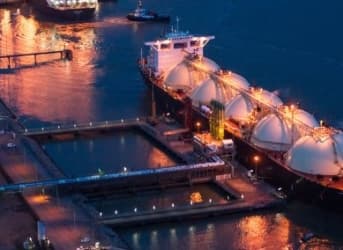More liquefied natural gas (LNG) will be leaving the U.S. come the New Year, even though the market for the chilled gas bound for export markets is softening.
As production from U.S. shale gas fields ramped up in recent years, including the monster, mile-deep Marcellus basin, which alone produces 113 billion cubic meters (bcm) a year, the same as Russia's exports to Europe through three pipelines, there seemed to be a grand opportunity to take advantage of the increased production by shipping gas overseas. Developers initiated large capital projects to build LNG export plants in the United States, including Sabine Pass, Cameron LNG, Freeport, Coos Bay, Lake Charles and North Slope, Alaska.
Then came the oil price collapse, and with it, the price of LNG. LNG rates have also been hurt by declining demand in the key import markets of Japan and China. Oilprice.com reported recently that Japanese LNG imports were down by a third between April and September. The return to nuclear power in Japan is also troubling for the LNG sector. In China, the great hope for LNG exporters, imports are also down, by 3.5 percent this year, with the country showing signs of a gas glut.
In fact according to the International Energy Agency, the LNG market is expected to be oversupplied for some time to come, due to fewer buyers than sellers: “[T]here is also an increasing share of gas available on a short-term basis,” and the “net result over the next few years is expected to be that significant volumes of gas will be looking for a home, at a time when lower oil prices are keeping down the price of oil-indexed gas sold under long-term contracts and when large new LNG plants are scheduled to start operation,” states the IEA. Related: Can We Blame Hedge Funds For Low Oil Prices?
Meanwhile, LNG tankers are lining up in Louisiana.
In January, Cheniere Energy's Sabine Pass facility will be the first to export gas from U.S. shale fields. The company expects to add a new production train every six months until mid-2019, with the seven total trains accounting for around half of the 65 million tons of annual LNG export capacity under construction in the United States. Most of Cheniere's LNG has already been sold through long-term contracts, with French energy company Engie (formerly GDF Suez) and rival EDF both signing supply agreements.
Along with Sabine Pass, another three LNG plants are slated to be approved by the U.S. government. They have been a long time coming. The Obama administration has not been quick to approve new LNG export terminals, partly because it does not want to lose the advantage that low-cost gas affords industry that uses gas as feedstock. The Daily Telegraph reported that “a corridor from Houston to New Orleans has attracted 33 petrochemical plants worth over $1 billion each since 2011.”
However the administration believes that the country has such a big lead over industrial competitors in Europe and North-East Asia, the latter where gas is four times more expensive than in the U.S., to worry about LNG exports to those regions bringing down the price of gas and eating into U.S. market share, according to The Telegraph. Related: An Unnoticed Casualty of The Commodities Price Drop
While the regulations around natural gas exports in the United States can be cumbersome, The Brookings Institute pointed out that not a single project so far has been rejected.
Another reason for less enmity toward LNG exports - whose opponents say that pushing more U.S. gas out of the domestic market for export will raise prices and hurt those businesses that buy it – is more political. Recent aggressive moves by Russia against Ukraine, through which Russian gas travels to markets in Europe – is making the export of U.S LNG an important geopolitical lever to contain Russian ambitions. Last year at the economic summit in St. Petersburg, Russian president Vladimir Putin warned that U.S. shale is changing the international political order. The Telegraph notes that any future American cargoes of LNG would erode Gazprom's pricing power in Europe. The EU already has a large network of import LNG terminals, with an increased total gas capacity of 221 billion cubic metres by 2016.
On the compressed natural gas (CNG) side, the Obama administration is also opening up opportunities for exports. Last month the Energy Department gave the green light for Emera, a Canadian company, to export North American CNG to countries that do not have a free trade agreement with the United States. (Federal law requires approval of natural gas exports to countries that do have an FTA with the U.S.) In the Emera case, the Energy Department said the export of 0.008 billion cubic feet per day of natural gas for 20 years would “not be inconsistent with the public interest.” Related: Oil Sands Producers Can Live With Alberta’s New Carbon Taxes
The last, and perhaps most interesting question, though, is why would companies want to export LNG or CNG in this low-price environment? Bloomberg recently quoted Zin Smati, the president and CEO of Engie, as saying that the landing prices in Asia are currently too low to make profits.
When the gap between LNG prices in Asia and the U.S. was over $14 per million BTU, there was plenty of room to make money. Now that the spread is less than $5, it doesn't make a whole lot of sense, says Smati.
ADVERTISEMENT
“You cannot ship gas from the United States anymore,” he said at an energy conference in Houston in September. “Nobody really is making money from LNG now. Certainly we are not.”
By Andrew Topf of Oilprice.com
More Top Reads From Oilprice.com:
- ISIS, Turkey And Oil – The Bigger Picture: Interview With Pelicourt
- Energy Markets On Edge As OPEC Meeting Nears
- Saudis Force Russian Ural Blend To Discount In This Key Market


















